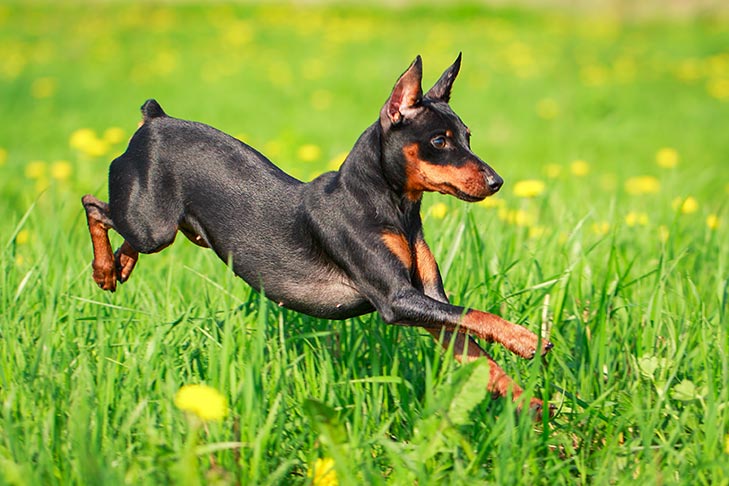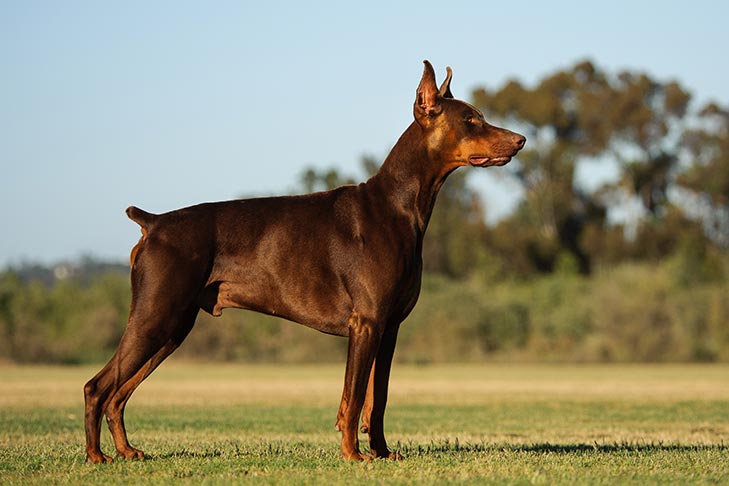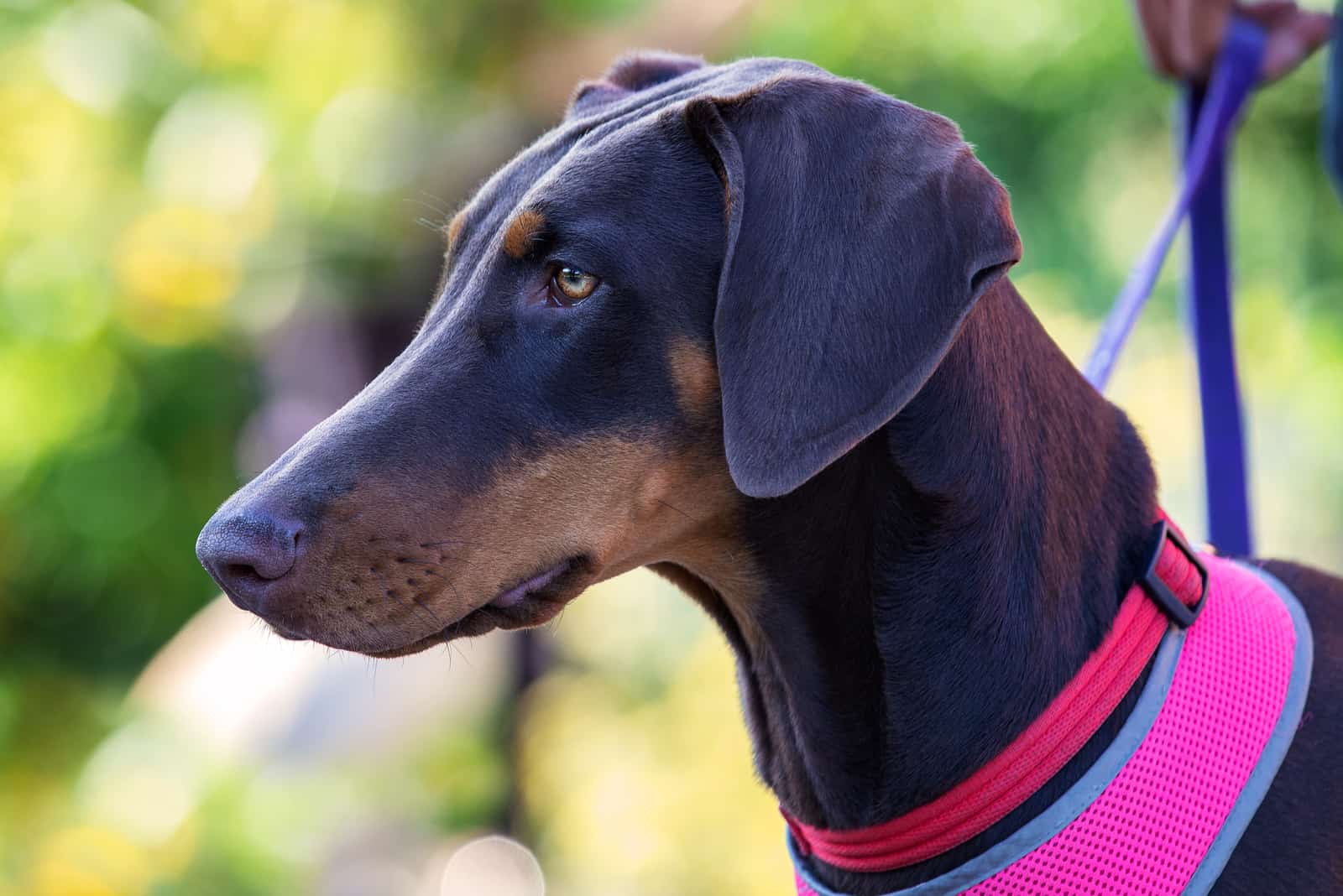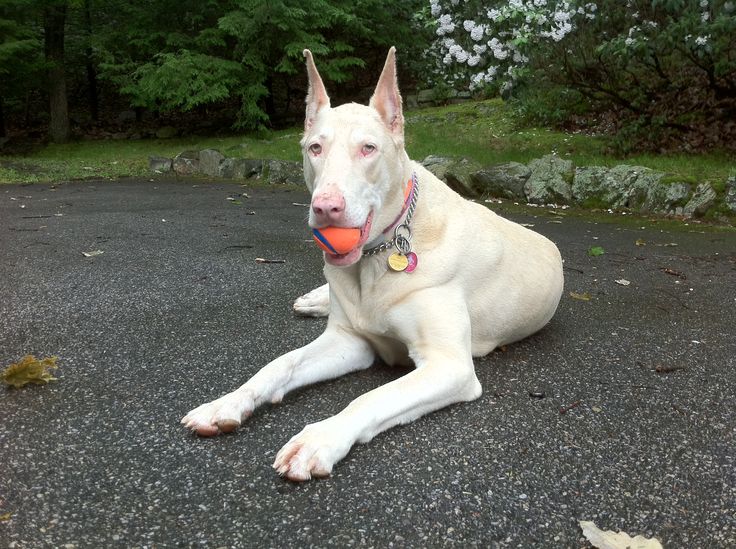Louis Dobermann, a German tax collector and first to breed the Doberman Pinscher, is believed to have done so in late 1800s. He probably crossed Rottweilers with German Shepherds and Weimaraners.
Doberman Pinschers are loyal dogs that are intelligent and can guard their home. This breed is often used as a family pet, but it can also be used to guard, police, guide, search and rescue, and security.
In this article, we will show you how many colors Doberman dogs have!
Doberman Colors
#1 Black and Rust

The most popular color for Dobermans of all kinds black and rust are one of most famous Dobermans. This includes those who starred in Magnum PI, the TV show, Magnum PI and the 1979 James Bond movie, Moonraker.
Popular for their shiny, sleek coats They look even more intimidating in black. Black is an dominant gene, and the genotype that causes the black and tan coloring is known as BBDD. with B representing the gene for black and D representing the absence of diluting.
While Dobermans with rust and black coats generally are healthy and exhibit the ferocity and devotion that are characteristic of their temperament, however, they are more susceptible to overheating. Their black coats are more able to absorb sunlight’s rays as compared to lighter coats, which puts them at a higher danger of suffering from overheating.
The Federation Cynologique Internationale (FCI) the black and red Doberman is among the two color options within the breed, the one is ” brown with rust red.” This is in contradiction to the breed guidelines for both the American Kennel Club (AKC) as well as the United Kennel Club (UKC) and both of them provide ” black, red, blue, and fawn (Isabella)” as acceptable colors.
#2 Red and Rust

The red and the rust Doberman isn’t as widespread than the black and the rust breed, mostly because the gene for black (B) prevails above the red gene (b). Two Dobermans with red genes that are bred to each other will result in an entire litter of red pups However, in the event that the parent of one is black, and doesn’t have the red gene the puppies will be black.
Red Dobermans are frequently considered to be more friendly as well as less destructive than black or rust-colored counterparts but there’s no scientific basis to prove that assertion.
The majority of red Dobermans are as active and healthy as other colors and more robust to the summer heat better as well than black or rust variety.
While all Dobermans are susceptible to allergies on the skin, the red Dobermans are particularly susceptible to developing issues with acne and loss of skin in their early years and during stressful times.
Some red Dobermans might have the genetic skin condition muzzle folliculitis. It is common in short-coated breeds. It causes lesions to develop around the muzzle lips and the chin. Fortunately, this problem is fairly manageable with oral antibiotics, as well as topically applied antimicrobial shampoos and lotions.
If you’re keen on having a red Doberman and you want to help to prevent skin problems by placing your dog on a fresh or dry diet specially designed for dogs with sensitive stomachs and skin.
#3 Fawn or Isabella

Dobermans with colors like Isabella or Fawn aren’t as popular as black and rust, or red and rust. some suggest that this is among the rarest of all Doberman colors.
With their lighter brown or beige coats, Dobermans have more resemblance to their Weimaraner relatives than their rust or black counterparts do. In actual fact, the term Isabella is applied to describe a nearly the color of lilac, which is typically observed within the Weimaraner.
The gene that is responsible for the dilution of this gene is known as Melanophilin. It is responsible for causing an enlargement of red genes. As such, ” a “red” Doberman (bb) with both dilution genes present (dd) is a fawn Doberman.”
While Fawn and Isabella is considered to be a good color for the breed as per both AKC as well as the UKC however, many believe that lighter-colored Dobermans are less desirable than their red and black counterparts. In fact, Dobermans with fawn tend to be “highly predisposed to color dilution alopecia” and could suffer from symptoms like dorsal and folliculitis very as early as.
Dobermans who are Fawn are at a 75% probability of developing alopecia due to color dilation that could, in the most severe instances, can make them hairless at the age of at least two years old.
The color is also present in several different breeds (apart from Dobermans and Weimaraners) like Pitbulls (namely that of the blue Pittie with a fawn), Cane Corsos and Border Collies.
#4 Blue

Blue is another diluted coat color that’s found naturally on the Doberman breed. As with the fawn type They generally sport the same rust-colored feet worn in both black as well as red Doberman However, this is where the similarities end.
Instead of the deep chestnut color that is characteristic of Red Doberman or the shining ebony of the black version the blue Doberman is a silver color coat that shines in the sunlight. Certain blue Dobermans could appear darker in comparison to others, with gray or charcoal-colored coats.
Blue is the dilute variant of black, the dominant gene within the Doberman’s DNA. it’s possible that fawn is not as prevalent because it’s a dilute version in the recessive genes red.
However blue Dobermans are more likely to be affected by color dilution alopecia. the prevalence of this disease up to 93 percent in blue Dobermans.
Breeders who concentrate on breeding one color are reliant on a small gene pool, which makes producing healthy offspring difficult. Blue Dobermans aren’t just more likely to suffer from health problems, but they could also be aggressive or have bad temperaments, making them unsuitable for pets, and are not suitable for the show rings.
Although certain breeders are known to are proud to produce the four shades of Doberman which include black red, fawn, and blue, without compromising their health or temperament.
Despite the genetic challenges caused by blue and fawn Dobermans, these distinctively colored dogs can be purchased for between $1500 to $2,500, while the more usual Dobermans with rust and black colors are priced a little lower at $800-1,500.
#5 Cream or White

A ivory or cream-colored Doberman is an uncommon sight , and it is not something or both the AKC or UKC consider acceptable. Sometimes, they refer to them as partial albino, these white dogs have the condition called leucism that causes an involuntary loss of the pigmentation.
The absence of pigmentation of the creamy Doberman is the cause of the light color of the coat. It is also responsible for their pink noses, rims of the eyes and lips, as well as blue eyes.
First White Doberman came into the world in 1975, and was the result of two parents who were black and rust. Padula’s Queen Sheba known as she was referred to was not the first ever white Doberman puppy, but she was the first to live as the previously white puppies might have been killed because of their appearance.
While Sheba has been classified an albino geneticists believe that the creamy hue that her hair exhibited suggests she was not completely deficient in pigment.
In Sheba’s time she was questioned by many about her lineage and suggested that she wasn’t purebred Doberman however, she must have inherited her unique color from other breed. 11 years after her birth her owner was finally in a position to prove her lineage as purebred and was able to be registered in the AKC.
Dobermans of all white and cream have been around since Sheba are descendents of her, therefore the light blue-eyed Dobermans that you observe today are probably inbred. This has resulted in numerous health issues that affect the white Doberman. They do not just have issues with their skin and eyesight however, they may also become more aggressive than the normal black and the rust Doberman.
Experts have speculated that the Doberman’s lack of eyesight can make it unsure regarding its surrounding. This causes aggression and can lead to fear bites, as well as other unintentional behavior.
The gene that is responsible for the coat that is cream-colored in the White Doberman is not related to other genes that affect color but obscures or conceals the intenseness of the dog’s color.
#6 Albino
The uncertainty over Sheba’s genetic condition suggests, Dobermans who are albino aren’t always easy to distinguish from people suffering from leucism. One of the easiest ways to differentiate between the two is through the hue the eyes. While the cream or white Doberman generally is blue in its eyes albino’s eyes appear pink or nearly completely colorless. Instead of the creamy hue that is typical of white Doberman Albino’s eyes is completely white, with a pinkish hue in its hair.
Like the white Doberman however, numerous Doberman experts and fans believe that the albino has a distinct temperament from the black, red blue, and fawn dogs and is often seen to have less intelligence and a greater fear of the unknown.
These issues with behavior may be related to health issues associated with albinism. Some studies are evidence suggesting that Doberman’s albino cognitive function may be affected due to ” the lack of specific receptors,” leading to them being highly unpredictable.
The most frequent ailments that are related to albinism include poor vision, photosensitivity, skin conditions and a poor coat. Melatonin’s deficiency genes may also lead to problems with kidneys and the liver. There is also evidence that suggests an increased risk of inheritable deafness in dogs with albino ears.
#7 Pure Black

Also called melanistic Dobermans these dogs are rare and do not have marks of rust at all. This unique hue is the result of an inherited mutation, rather than an actual color change. It is typically caused by the black dominant gene K as well as the extreme mark gene Elotus.
The color isn’t officially acknowledged, but many believe that the black solid coat is linked to the same health issues as the white pure variety. Some argue the melanistic animal is ” healthier and longer lived.” The melanistic wolf, for example is more resistant to disease and has a higher likelihood of surviving a killing since it is harder to spot.
However they are also the who are most likely to be struck by drivers due to their lack of visibility. Be sure to make the black Doberman wear the collar that is lit up whenever you take him out for walks at night.
Putting A Spotlight on The Different Varieties of Doberman
The majority of us, there’s only one kind of Doberman Pinscher that comes only in one color: black with rust-colored markings around the muzzle, legs, throat, and chest and also over each eye. Doberman lovers are however aware that there are three different kinds of Doberman that come in a variety of shades such as blue and Fawn.
The two most popular variations that make up Dobermans are the Doberman is two main breeds: the American as well as the European. The American Doberman is sleeker and more sleek The European is a stronger dog that has a larger chest and a more robust bone structure.
A. The American Doberman is considered more well-suited for the show ring and being a dog companion in contrast, Dobermans from Europe are more suited to the show ring. European tends to be more working breed. With its drive and determination it is the European Doberman excels in tasks of search and rescue, and is highly sought-after as a police or military dog.
In the end It was actually the American Doberman who aided the US army in each of the First as well as the Second World Wars, delivering messages, locating and rescuing wounded soldiers, guarding and serving as Scouts.
In addition to these two major types of Doberman there’s a third that is a bit more controversial known as The Warlock Doberman. Warlock Doberman.
While there is no way that a Doberman could be described as to be small, Borong the Warlock was one of the largest that was bred through Theodosia as well as Henry Frampton in 1955. Borong was a massive success on the show circuit, and was almost a legend as a sire, with numerous owners taking his females to breed.
The name Warlock was soon a synonym for any big Doberman and, later in the Seventies when the need for Dobermans that were bigger and stronger was at its peak Dobermans who crossed with larger breeds like Rottweiler and the Great Dane and Rottweiler became called Warlock Dobermans.
Certain breeders are still advertising Warlock Doberman puppies for sale however there is no distinction between these breeds as opposed to the standard Doberman.
History of the Doberman
Doberman Pinscher Doberman Pinscher is a well-known but relatively new breed which may be a little off-putting for certain, particularly those who are particularly hostile toward tax collectors.
Mark Twain once noted that taxidermists and tax collectors had several things in common, the only difference was the fact that “The taxidermist takes only your skin.” Being tax collectors today isn’t nearly as risky as it was in 1800s. In the past, taxes were collected by hand instead of being sent to the internet via electronic payment.
Not surprising, then, tax collectors were worried about their security. Karl Friedrich Louis Dobermann wasn’t just a tax collector; Dobermann also ran an animal pound in the area it didn’t take long for him to made two and two and made the decision to raise a puppy who could fight the most dangerous criminals and the most abrasive of customers.
Instead of breeding to impress, Dobermann focused on creating the dog that had the characteristics of an “unflappable temperament,” physical strength, and an inherent capacity to defend. While the exact roots for the Doberman Pinscher remain a mystery however, it is considered that German Shepherd played a role in Doberman’s strength as well as its intelligence and ability to obey. The Weimaraner is believed to have provided the hunter’s instinct and prey drive that allow the Doberman to sense danger and eliminate it.
The Rottweiler could also be a possible precursor in the lineage of Dobermann and is possibly responsible for the coat of black and tan and also the dog’s ability to act as guard dogs.
According to a long-time acquaintance from Dobermann, Otto Goller, Schnuppe, a crossbreed, was the mother of the first generation of Dobermans. Schnuppe was mated to what was called the “butcher’s dog” which many believe to be ” the ancestor of the present-day Rottweiler crossbred with a sheepdog.”
The early Dobermann breeding efforts were successful and some of his dogs displayed the same high level of desire to hunt that they were killed by local hunters following an overly enthusiastic hunting spree.
The Doberman that we have today has striking resemblances to Dobermann’s first attempts but is much more refined because of its efforts by Otto Goller and Philip Gruening who introduced Greyhound and Manchester Terrier to the breed. This helped give the Doberman the smoothness and speed we are familiar with today.
What’s The Most Popular Doberman Color?
Not only are the color black or rust by far the most popular color for Dobermans and tan, but it’s also one of the most popular. According to a poll carried out by the Doberman’s Den 62% of voters selected black and tan as their preferred color with red and Rust Dobermans being second place with 24 percent. Blue Dobermans were somewhat more popular than fawn which received 8% votes, as opposed to the fawn’s 6 percent.
Which Is The Rarest Color For A Doberman?
There are many different opinions as to which shade of a Doberman is the rarest. While some believe that the white or cream Doberman is the rarest while others believe that it is the black Doberman with no rust marks and rust marks, is the rarest of all. Others, however, claim that blue Doberman is the most common and accounts for only 8 to 9 percent of the breed.
Are Dobermans Dangerous?
While a trained Doberman is a great and devoted pet for your family, however, this breed is considered to be one of the most dangerous ones in the world. Breed-specific laws have also led to the Doberman being prohibited in several states that include Arkansas, Iowa, Kansas, Missouri, and Washington.